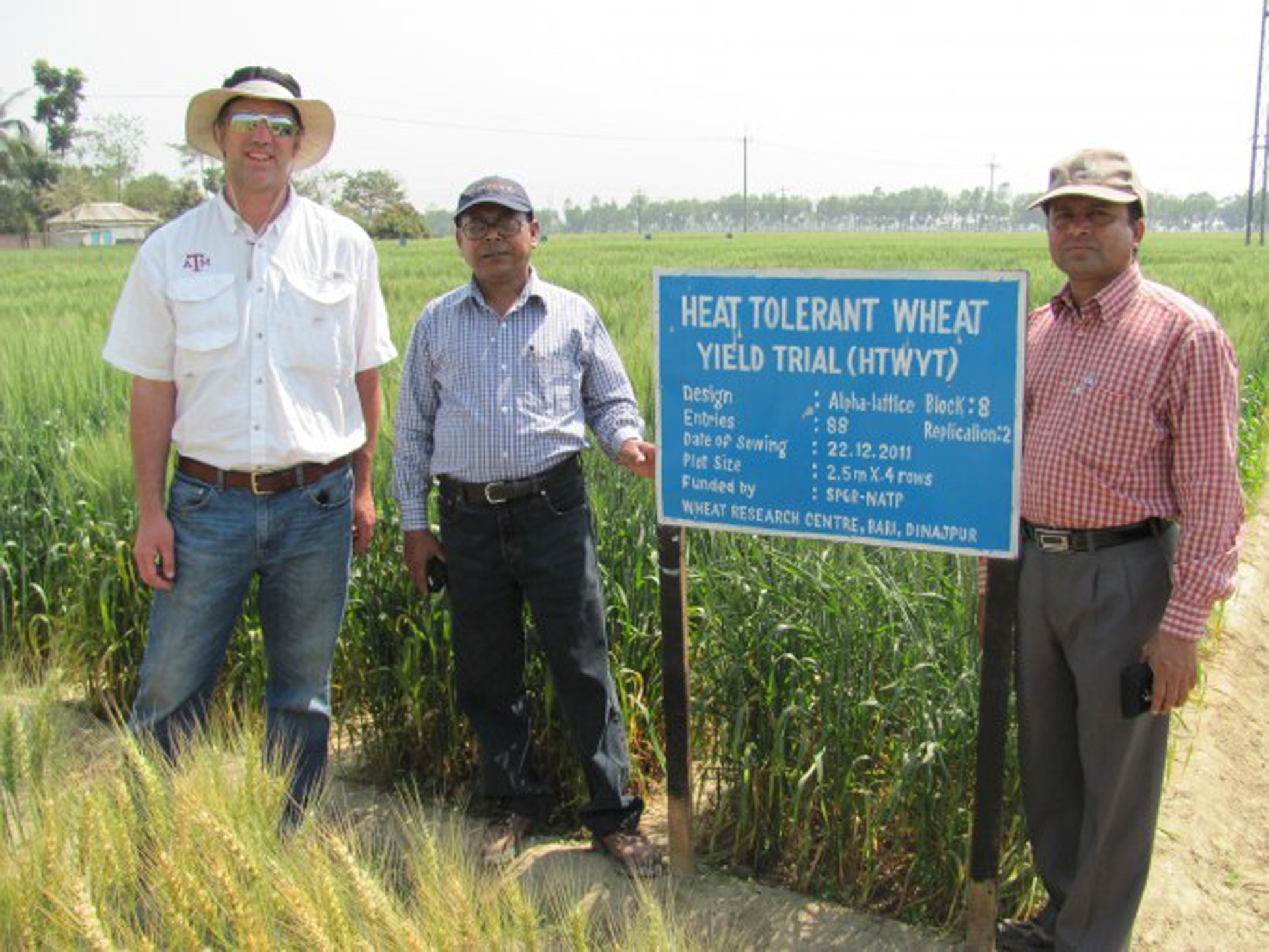|
Leaf wax may be key to drought and heat tolerance in wheat, says Texas A&M researcher
College Station, Texas, USA
September 7, 2012
Wax build-up is not always a bad thing, according to a Texas A&M University soil and crop scientist.

Dr. Dirk Hays, Texas A&M University associate professor of cereal grain developmental genetics, left, stands with Dr. Naresh Barma and Md. Abdul Hakim working at the Bangladesh Agricultural Research Institute in Dinajpur, Bangladesh, one of their study sites. The Bangladesh BARI is responsible for cultivar and variety development. (Courtesy photo)
Dr. Dirk Hays, associate professor of cereal grain developmental genetics, has been researching leaf wax, it’s variability in different genetic wheat lines and what difference the wax can make in heat and drought tolerance of the crop.
Hays recently returned from seven months of traveling on a Fulbright Regional Research Scholarship to India and Bangladesh.
“They have a similar problem to ours with terminal heat stress in wheat,” Hays said. “Their problem is chronic, steady increases in heat, which impairs wheat development and decreases yield and quality.
“Our problem is sporadic, where the stress occurs with spiked temperatures. Under both cases, wheat, as in most crops, is extremely sensitive to flower and early seed abortion due to high temperature stress.”
“What I have been looking at is a wheat mapping population, trying to find genes that are regulating heat and drought tolerance,” he said. “The main goal was to define the genes that regulate leaf and glume wax, and how increased wax content improves heat and drought tolerance.”
Hays said his research has found big genetic variations in the amount of leaf wax on leaves and glumes between different genetic wheat lines. This variation can be as high as 10- to 20-fold in the amount of leaf wax between cultivars.
“But you can’t visually score that; you have to chemically quantify it,” he said. “We’ve found if leaf wax is quantified and mapped, it can result in up to a 25 percent increase in yield. The higher wax keeps the plant cooler and reduces the amount of water the plant uses to keep itself cool.”
Hays said during his seven months overseas, he was working with the local scientists to convey how to measure the wax content in different lines and then how to use that as an improved selection tool for drought-tolerant wheat.
“While I have done extensive work on leaf wax here, this was another environment where I could verify these characteristics make a difference in improving heat and drought tolerance.”
Bangladesh and India are potential hot spots for global warming, he said, and both have grown wheat for more than 1,000 years.
In India, the farmers grow primarily a spring wheat crop under both dryland and irrigated conditions. But they are facing dropping water tables and more sporadic monsoon seasons, Hays said. Crop yield trends have shown a plateau, indicative of the negative impact of global warming.
“It’s imperative that we stay ahead of global climate change and improve the adaptation of wheat and other crops to increased high temperature stress, especially during the vulnerable reproductive stages (flowering and early seed development),” Hays said.
“Their crops are probably better adapted to heat stress than ours are, so the learning was definitely a two-way collaboration,” he said.
In India, he worked at Banarus Hindu University with Dr. V. K. Mishra and in Bangladesh he was at the Bangladesh Agricultural Research Institute working with Dr. Naresh Barma.
“Bangladesh has a population of 160 million in a country the size of Louisiana,” Hays said. “They are self-sufficient with their rice and a dynamic vegetable market. India is on the margin of being able to feed itself. They have the highest amount of arable land, and it is very productive.”
Hays said the Fulbright scholarship offered him a good chance to build on this collaboration and make use of the two countries and their tremendous sources of environmental tolerance.
“We are working to improve the selection process,” he said. “We are looking at what they are already selecting for and what phenotypic traits are there.
“No one has analyzed the detail of leaf wax and the chemical composition,” Hays said. “But the growing interest now in genetic plant breeding is to package together traits – find optimal root or leaf structures and patch those into a cultivar that gives you ideal performance.”
Finding these optimal traits can be done by using genetic marker-assisted breeding to track the genes that regulate wax and root leaf structure for optimal performance under heat and drought stress, he said.
More news from: Texas A&M AgriLife
Website: http://agrilife.org/ Published: September 7, 2012 |